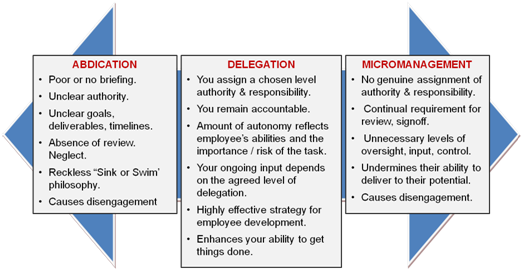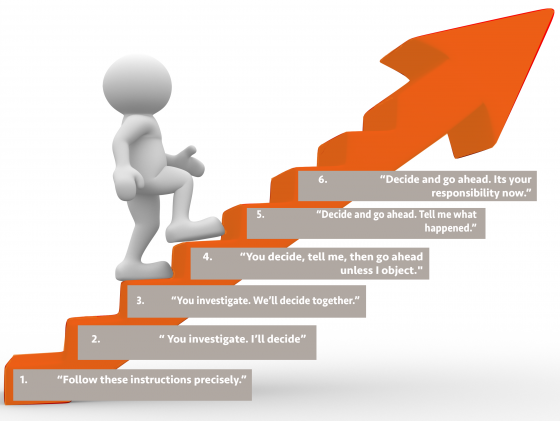Why delegate?
Becoming an effective delegator will leverage your time and grow the capability of your team. Good delegation involves setting clear expectations and monitoring progress appropriately. Use the tips for successful delegation below and the delegation conversation plan to help delegate effectively.
Good delegation is a conscious choice about how much authority and autonomy you hand over
Good delegation starts with being clear about what you are delegating. It also involves choosing how much authority and autonomy you delegate, balancing the capability of the person and the risks if things go wrong. Too much too soon, or lack of information could overwhelm a person and cause problems – too little and you may be micromanaging. Neither gets good results. Note: Council, through its delegation’s policy has placed certain limits on your ability to delegate some decisions/activities. You need to understand and comply with these limits. If you delegate someone to undertake all or most of the responsibilities of a larger job (e.g. step up as acting manager whilst their manager is on leave) this may entitle them to payment. Check there employment agreement or discuss with People & Capability.

Choose one of these six levels of delegation
The key to successful delegation is good planning, clear decisions about what exactly will be delegated (see below), a thorough briefing, acceptance of the brief, monitoring of progress, ‘no surprises’ and a thorough debrief afterwards. You must balance the degree of responsibility given against both the capability of the person and the risk if it goes wrong. The following six levels should allow you to choose a balance that works.

This is instruction. There is no delegated freedom at all.
3. This has an important difference from from level two. You’ve asked to see the analysis and recommendation, and you will check the thinking and the plan together before jointly deciding. This level of delegation encourages and enables the analysis and decision to be a shared process, which can be very helpful in coaching and development.
4. Now the other person begins to control the action. The default is now positive rather than negative. They are trusted to assess the situation and options and are probably competent enough to implement too, but for reasons of task importance, or competence, you prefer to retain a veto. This is a very liberating change in delegated freedom. You can also use when seeking responsibility from above. For example, “Here is my analysis and recommendation; I will proceed unless you tell me otherwise by (date).”
5. This delegation level saves even more time. It also enables a degree of follow-up by the manager as to the effectiveness of the delegated responsibility, which is necessary when people are being managed from a greater distance, or more ‘hands-off’. The level also allows and invites positive feedback by the manager.
6. The most freedom that you can give to the other person, and not generally used without formal change of a person’s job role. It’s the delegation of strategic responsibility. This amounts to delegating part of your job – not just a task or project. You’d use this utmost level of delegation (for example) when developing a successor, or as part of an intentional and agreed plan to devolve some of your job accountability in a formal sense.
2. You want research or analysis but not recommendation. You retain responsibility for assessing options and making decisions.
Tips for successful delegation
You cannot go wrong if you....
- Match assignments with competence… Use the six levels of delegation to choose an approach that balances the skill, ability and confidence of the employee against the risk and impact of failure for the organisation. Explain your decision and check they are comfortable with that. In particular be clear whether decision making is delegated or joint.
- Be specific… It’s easy to give someone a vague assignment (“You take care of the Xmas party”) only to find out later that what they understood this to mean is very different from what you intended. People need to know what tasks they’re responsible for and what the finished product should look like. Be a S.M.A.R.T delegator.
- Don’t micromanage. Tell them enough so they understand what’s expected of them, but not so much that they have no chance to think for themselves. Leaving the person room to make some independent decisions lets them choose a style of doing things that suits them best. It makes them feel respected and trusted and part of the team. It builds a greater sense of pride and ownership in the project, and it gives them a chance to develop their skills and confidence. They might not do the outstanding job that you think you would have, but it might still be good enough-and the benefits to the person doing it are probably worth the tradeoff……… So learn to let go!
- Agree deadlines. Make sure the person understands when they can expect things they need from other people, when their part of the task needs to be done, and how this fits in with the larger timeline for the whole project.
- Monitor progress. Check back with the person you’ve delegated to, to find out how it’s going. Ask if any questions have come up since you last talked. Make sure they have what they need to do the job, and that they’re getting the necessary assistance and cooperation from others.
- Document. Use a standard template for setting expectations when you delegate larger projects. For instance, you might want to: describe the outcome you want, including the criteria that must be met; list the reasons why; and discuss the roles, responsibilities and authority of everyone involved.
- ‘No Surprises’. Make it clear that if anything gets in the way of delivery they are responsible to advise you ASAP so together you can decide how to proceed.
- Debrief. Give accurate and honest feedback. People want to know how they’re doing, and they deserve your honest opinion. Praise effort and good work, but also let them know where they might have done better. Encourage risk-taking and growth by treating mistakes and less-than-successful efforts as a chance to learn and do better next time.
Delegating a Large Task or Project
You may find the delegation project brief template useful if you have a large complex delegation to make. It achieves agreement between the manager delegating and the employee(s) on nine key dimensions of the delegation.
The best way to use the project brief is usually to part complete the template and work through it with the employee(s) receiving the delegated task or project. At that point give the employee(s) a short period of time to think about things and bring back to you a project brief they consider final and which they can accept. Review that project brief together, finalize and sign off. They then have the autonomy to do any further detailed planning they wish and you can be confident their efforts will remain within a framework you are comfortable with including whatever review arrangements were agreed in the project brief.


